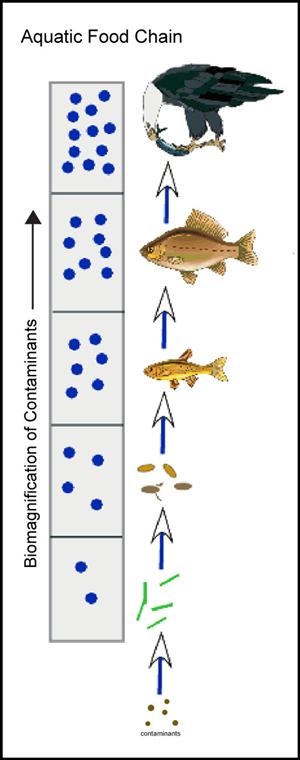Human Influences on Aquatic Ecosystems
Human activities affecting aquatic ecosystems are more likely to disrupt natural patterns and processes because species do not have the ability to adapt to the rapid changes to their environment that can occur. Human influences in the lower Athabasca basin include the oil sands operations, pulp and paper mills, municipal discharges, and, to a lesser extent, forestry and agriculture. Some of the specific impacts on aquatic ecosystems related to these influences are discussed in the Resources section. More general issues associated with human impacts on aquatic ecosystems are described below.
Bioaccumulation and Biomagnification
Some contaminants that enter aquatic systems are preferentially stored in organisms, usually in fat tissue, rather than being released or excreted. This results in an accumulation of the contaminant over time in a process known as bioaccumulation.
Biomagnification refers to the higher concentrations of contaminants in organisms at higher trophic levels within food webs. While an organism in a low trophic level of a food web may contain low levels of a contaminant, its consumer will concentrate the contaminant as it consumes many of these individuals over its lifetime. At each trophic level in the food web, contaminants become more concentrated. Contaminant accumulation is higher in food webs with more steps to the top predator. Therefore, the top predator in systems with longer food webs usually has higher contaminant concentrations than those in shorter food webs, all else being equal.
The amount of contaminants deposited in aquatic ecosystems is not always as important as the length of the food web (Campbell et al. 2003a, 2003b). Therefore, it is important to consider the type of food web in an aquatic system to anticipate the effects of pollution.
Endocrine Disrupting Substances
Endocrine disrupting substances (EDS) are pollutants that have the ability to alter the growth, reproduction and general development of an aquatic organism. EDSs can be found in agricultural pesticides, alkylphenolics (detergents used to remove oils) found in industrial and municipal effluents, and natural hormones and synthetic steroids (such as those found in contraceptives) found in municipal effluent and agricultural runoff. EDSs can cause deformities in fish embryos, impair fish reproduction and cause the feminization of fish. For more information see the National Waters Resource Institute.
Climate Change
Modelling conducted by the Northern Rivers Basin Study (NRBS) indicated that global climate warming could result in earlier spring melt, higher levels of rain and snow, and an increase in evaporation (NREI 2002). Together, these changes could result in an overall decrease in Athabasca River water levels. Warmer temperatures causing earlier melting of ice jams could affect the replenishment of lakes and ponds, resulting in lower water levels. Increases in water temperature could the survival and reproductive success of fish species such as trout and burbot (Hynes 1970). Warmer temperatures and changes in water quantity could therefore affect species composition and survival in the oil sands region.
Atmospheric Deposition
Oil sands operations and pulpmills release gases and small particulate matter (PM) into the atmosphere. These substances can then be deposited on the land or water by dry or wet deposition (when rain or snow bind to the gases or particulates).
Sulphur dioxide (SO2) and nitrogen dioxide (NO2) are examples of contaminants found in the atmosphere. These gases are associated with acid rain and the acidification of sensitive lakes and soils in the oil sands region.
Mercury is of particular concern in the northern rivers of Alberta. At the regional level mercury, is primarily emitted from coal power generation plants near Edmonton and in lesser amounts from the oil sands operations (NREI 2002). Mercury can travel long distances through the atmosphere and is eventually deposited in aquatic environments, where it can be toxic to aquatic organisms









